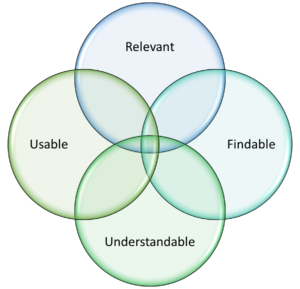An international standard for plain language? Yes please!
ISO 24495-1 Plain language – Part 1: Governing principles and guidelines
What is an international standard (ISO)?
ISO standards are developed and written by experts as a description of “the best way of doing something”. https://www.iso.org/standards.html
ISO standards are used for things like food safety, work health and safety, medical devices, child car seats, and even date and time formats. The standards aim to provide a recipe for the safest or best ways to do things so that everyone can be safer and more confident that products and systems are held to a quality standard.
Why is a Plain Language ISO exciting?
Plain language definitions have been around for a long time and many governments and organisations have embraced it. An international standard now provides a consistent definition and agreed approach to implementing and measuring plain language in any context.
So, what is plain language according to the ISO?
The plain language ISO is explicit in having a focus on written language. Plain language means that the reader can find the information they need, understand it, and then use that information. Of course, this can apply to other forms of language, not just written.
The standard has four guiding principles:
- Relevant – documents have information that readers need.
- Findable – information is easy for readers to find.
- Understandable – information is easy for readers to understand.
- Usable – documents can be used by readers to achieve their purpose.
This emphasis on what readers need means that feedback is an important part of creating any written information. The standard also takes emphasis away from readability formulas as an indicator of plain language – the focus is on who the readers are and what language they need and understand. The standard helps writers to understand the steps to use plain language.

What happens next?
Plain language will not magically appear everywhere just because the plain language ISO exists. Governments, organisations, and businesses will need to make a commitment to understanding and implementing the standard.
The exciting part is that the determination of what is ‘plain enough’ isn’t up to governments, organisations, or businesses anymore. Readers are the judges of what is plain language! Readers will need to answer “yes” to each of these questions when reading a document:
- Does it have the information you need? (relevant)
- Can you find the information you need? (findable)
- Can you understand the information once you find it? (understandable)
- Can you use the information to achieve your purposes? (usable)
It will be up to writers to find ways to connect with readers and keep working to make documents plainer and ultimately more usable.
I do get a bit confused with definitions of Plain Language. If it is defined as information relevant, understandable, usable, and findable… and it is content written for a person with a particular level of intellectual disability (or rough reading level), does in mean that Easy/Plain English is actually Plain Language for a particular population and purpose? Or am I being too literal?
I agree Sheri, it can get quite confusing! The ISO does briefly comment on the difference between “plain” and “easy”. It indicates that “plain” language is more of a universal strategy that all audiences can benefit from and “easy” language is intended for more specific populations. At the end of the day, I just love the emphasis on what the audience needs! Happy to chat more to clarify!
Great Blog and research link to refer to
In my experience simple plain language when reading, listening to a helpful sermon or looking at a website;
* redundancy of main ideas once
* redundancy of detail points omitted
* choose sumple rather than complex sentences
* choose active rather than passive voice
* selective use of visual enhancements
* use vocabulary the average listener or reader understands
* explain new vocubulary as it occurs
* written communication is a conversation and requires tuning in to the recipient.